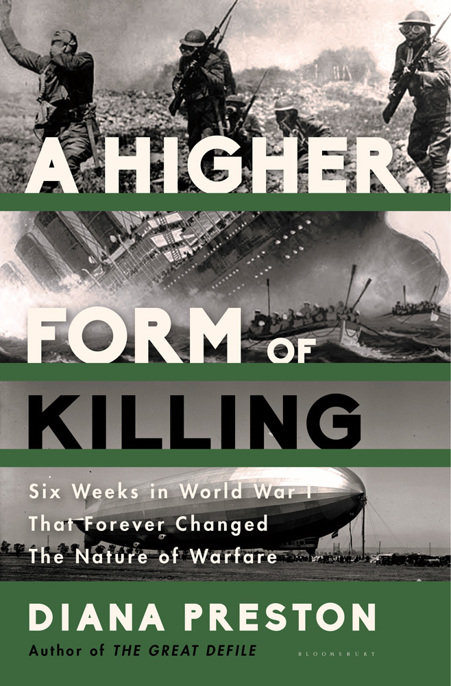
A Higher Form of Killing
Six Weeks in World War I That Forever Changed the Nature of Warfare
کتاب های مرتبط
- اطلاعات
- نقد و بررسی
- دیدگاه کاربران
نقد و بررسی

Starred review from February 9, 2015
Historian Preston (Before the Fallout) places the creation of poison gas, the torpedo, and the zeppelin into the context of warfare and the human toll exacted in a well-detailed, shattering survey timed to mark the 100th anniversary of the weapons' use in WWI. She explains the scorched-earth policy of Germany under Kaiser Wilhelm II, which mandated a complete triumph for the Fatherland at all cost during the infamous six-week period in 1915 where this trio of deadly weapons was introduced to untold suffering for soldiers and civilians alike. Conventional war, as Preston writes, entered a new phase of killing when poison gas was dropped on unsuspecting French and Canadian soldiers in the trenches at Ypres, Belgium, on April 22; when a German submarine torpedoed the Lusitania on May 20; and when a German zeppelin bombed London on May 31. Confidential talks, last-minute compromises, and bogus assurances comprise the dark heart of this dramatic account as the merchants of conflict seek to heighten mass panic, terror, and death regardless of traditional military rules. This is Preston at the top of her analytical form, offering fascinating modern parables on war, mortality and civilization.

Starred review from December 15, 2014
A British historian of considerable breadth and accomplishment, Preston (The Dark Defile: Britain's Catastrophic Invasion of Afghanistan, 1838-1842, 2012, etc.) focuses on three wartime innovations that elevated to new heights mankind's ability to slaughter itself: submarines, zeppelins and poison gas.All were advanced to marvelous efficacy during the first weeks of World War I, thanks largely to the technologically savvy Germans, who shook off the world's condemnation of their first use of asphyxiating gas to spur the trench stalemate in Belgium, with the justification that the other side would promptly use it, too-and they were right. The first Geneva Convention in 1864 drew up agreed-upon protocols for treating the sick and wounded in war and created the Red Cross. The Hague Peace Conference of 1899, in the cause of "humanizing war," considered banning certain weapons, such as asphyxiating gases and projectiles and explosives launched from the air. To little avail: Count Ferdinand von Zeppelin had secured German financing for his dirigible prototype by 1900; the first U-boat had arrived at the Krupp's plant in 1906 and was pushed into production because of British advances in submarines; and chemist Fritz Haber, director of the Kaiser Wilhelm Institute in Berlin, arrived at the solution to blow chlorine gas over enemy trenches. (Not to be forgotten is Alfred Nobel's development of dynamite and smokeless powder.) All available methods would be enlisted to help Germany embark on a swift and lethal thrust in the spring of 1915, dropping bombs by zeppelin over London, torpedoing the Lusitania and killing 1,198 people, and gassing troops of young men who had no idea how to manage a chemical attack. In what is often difficult but necessary reading, Preston provides haunting descriptions of the effects of poison gas. A harrowing-and, in this era of drones, absolutely pertinent-look at the rapacious reaches of man's murderous imagination.
COPYRIGHT(2014) Kirkus Reviews, ALL RIGHTS RESERVED.

January 1, 2015
Historian Preston (Before the Fallout: From Marie Curie to Hiroshima) presents a fascinating and chilling chronicle of weapons of mass destruction. The author begins with a brief summary of three groundbreaking events, including the torpedoing of the passenger liner Lusitania by a German submarine and the aerial bombing of London by German Zeppelins, both in 1914, the initial year of the World War I. These events violated peacetime rules established at the Hague Conventions of 1899 and 1907 and drastically changed the nature of warfare. The author then provides a concise yet comprehensive overview of rivalry that frames the context for these events. The bulk of the narrative consists of detailed, often firsthand accounts of each of these brutal attacks. This work will appeal to history buffs of all backgrounds who are intrigued by the physical and psychological damage inflicted by weapons of mass destruction. VERDICT Readers on the edge of their seats throughout Jared M. Diamond's Guns, Germs, and Steel: The Fates of Human Societies will find Preston's eloquent and objective history of war immensely exciting.--Marian Mays, Butte-Silver Bow P.L., MT
Copyright 2015 Library Journal, LLC Used with permission.

























دیدگاه کاربران